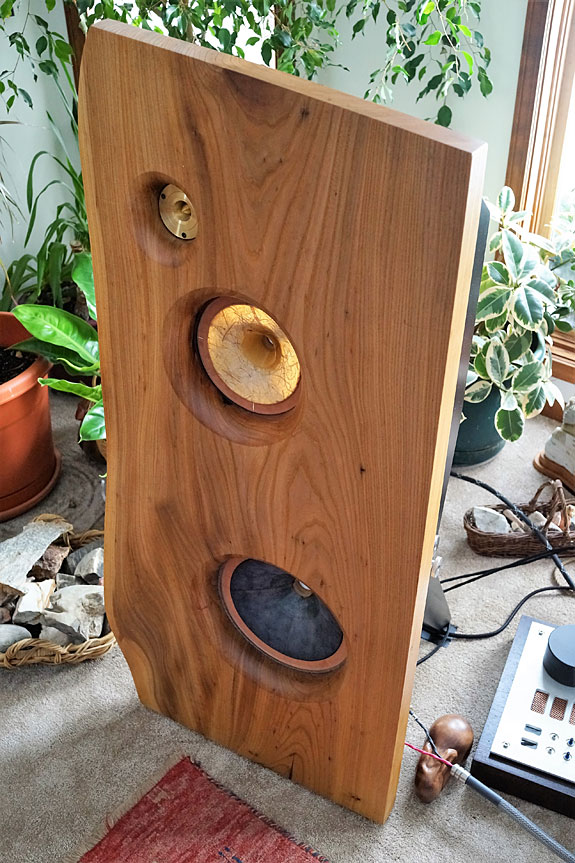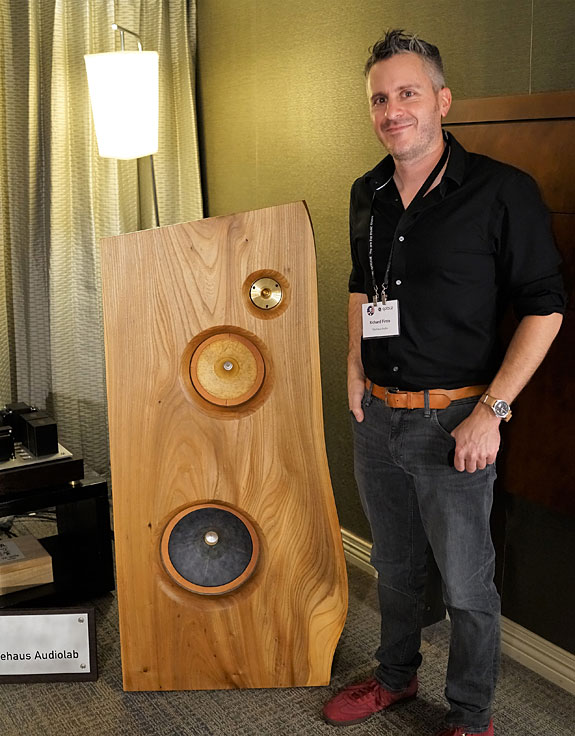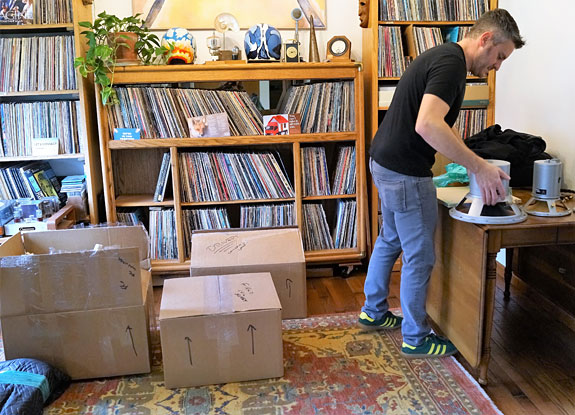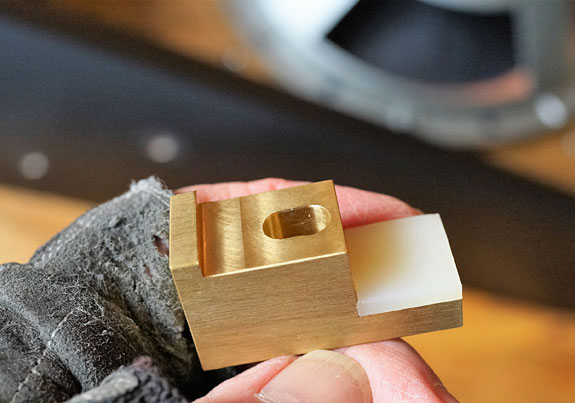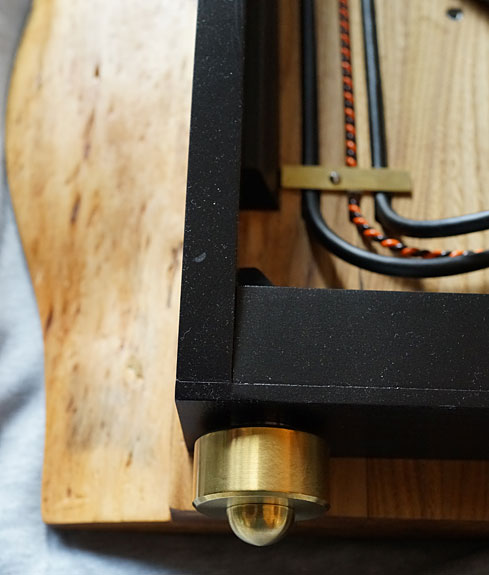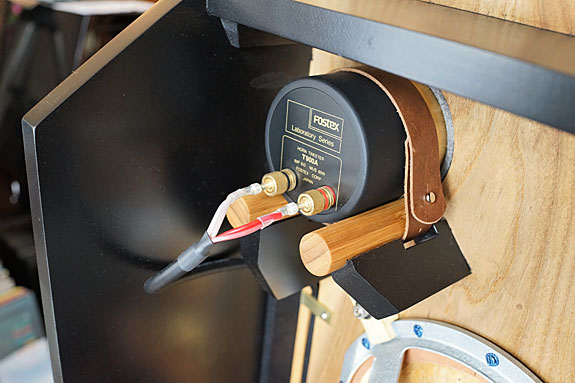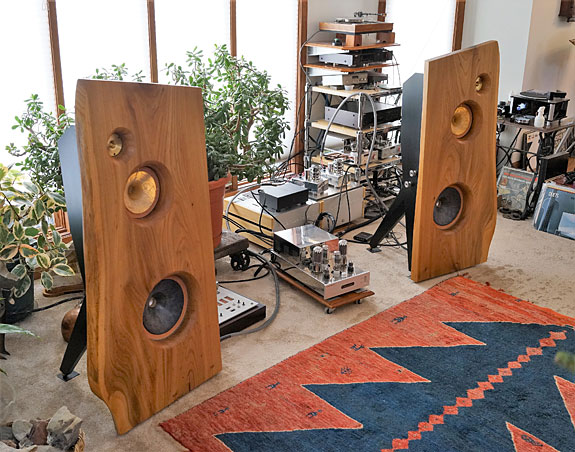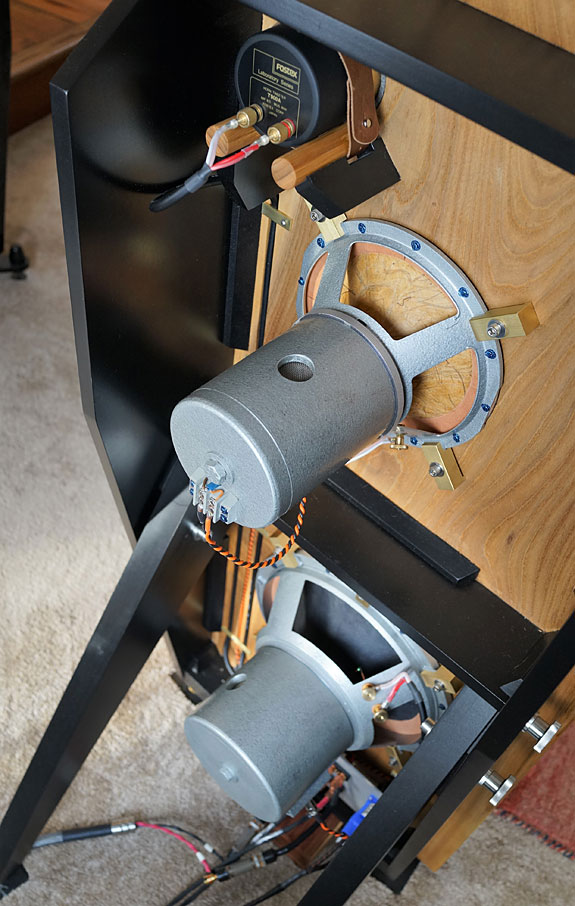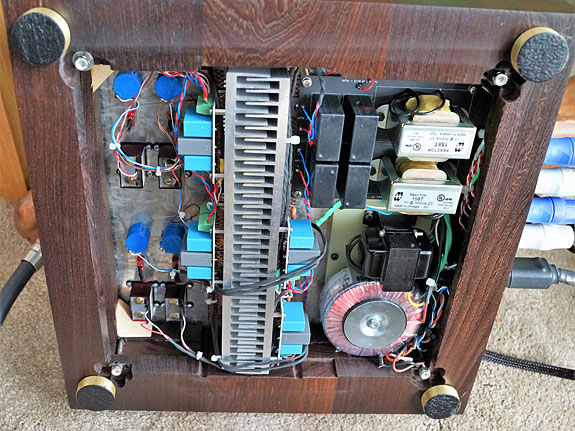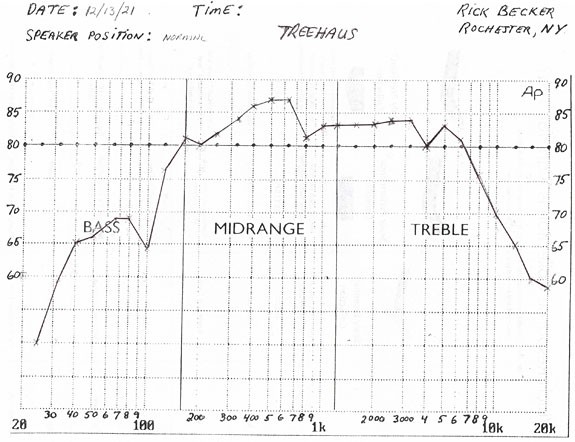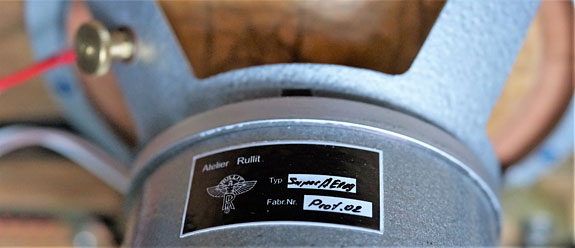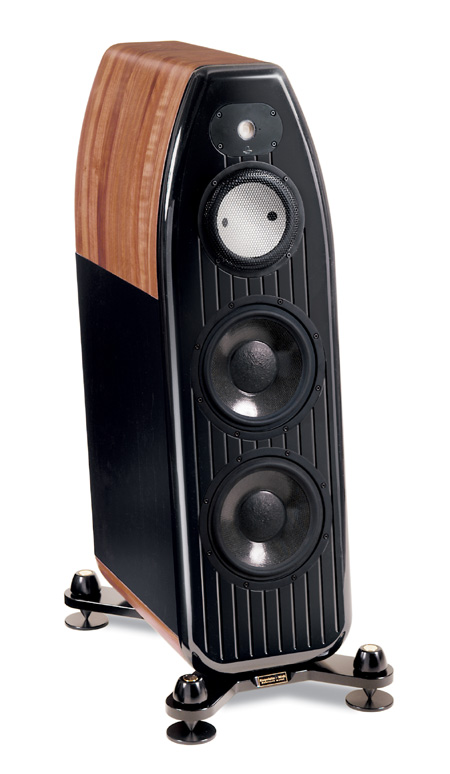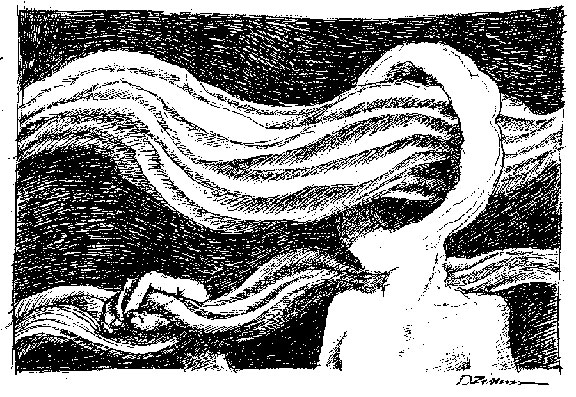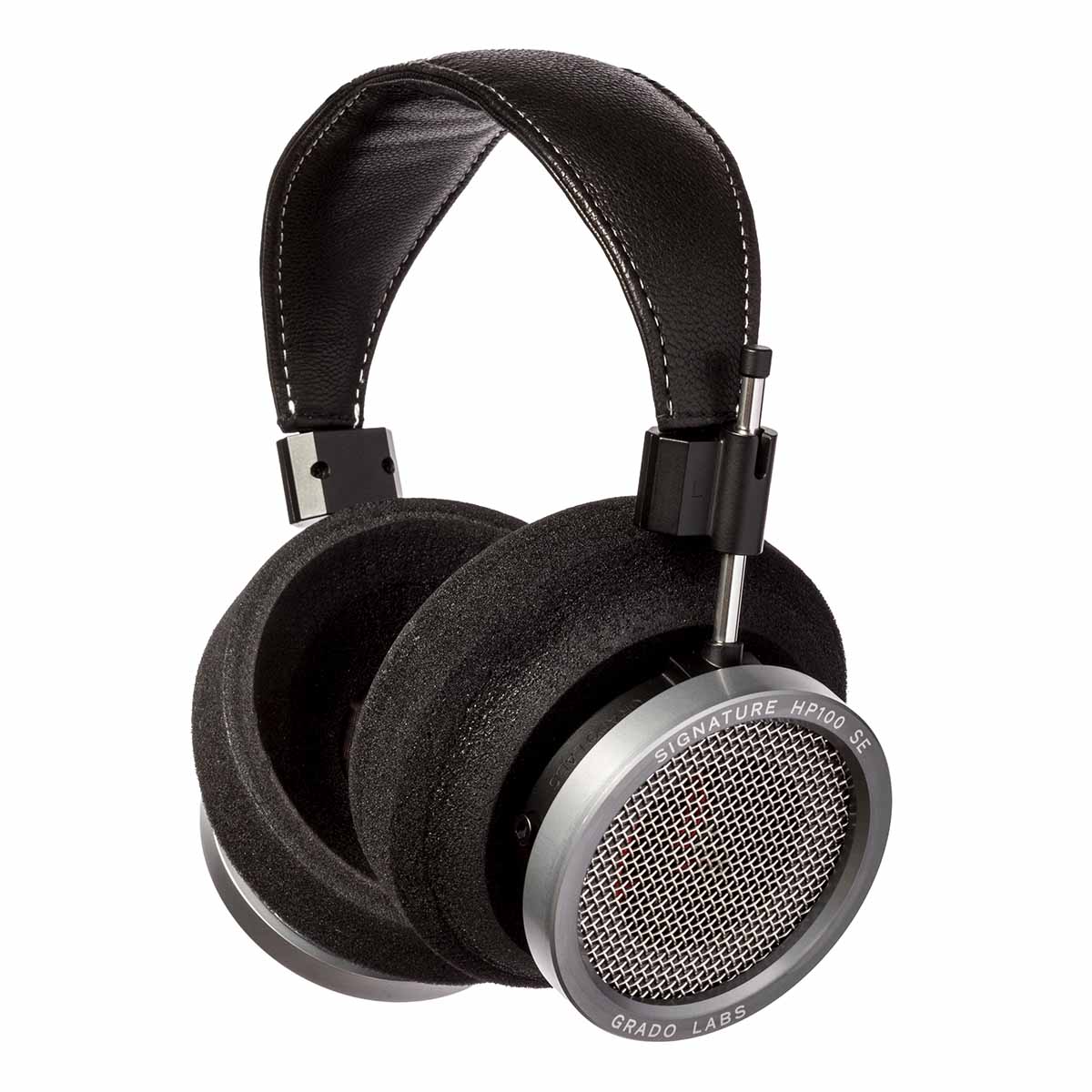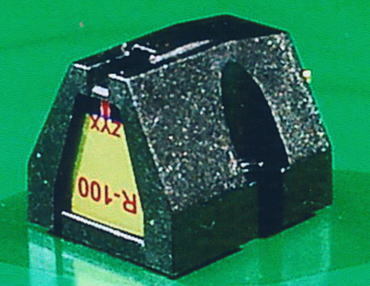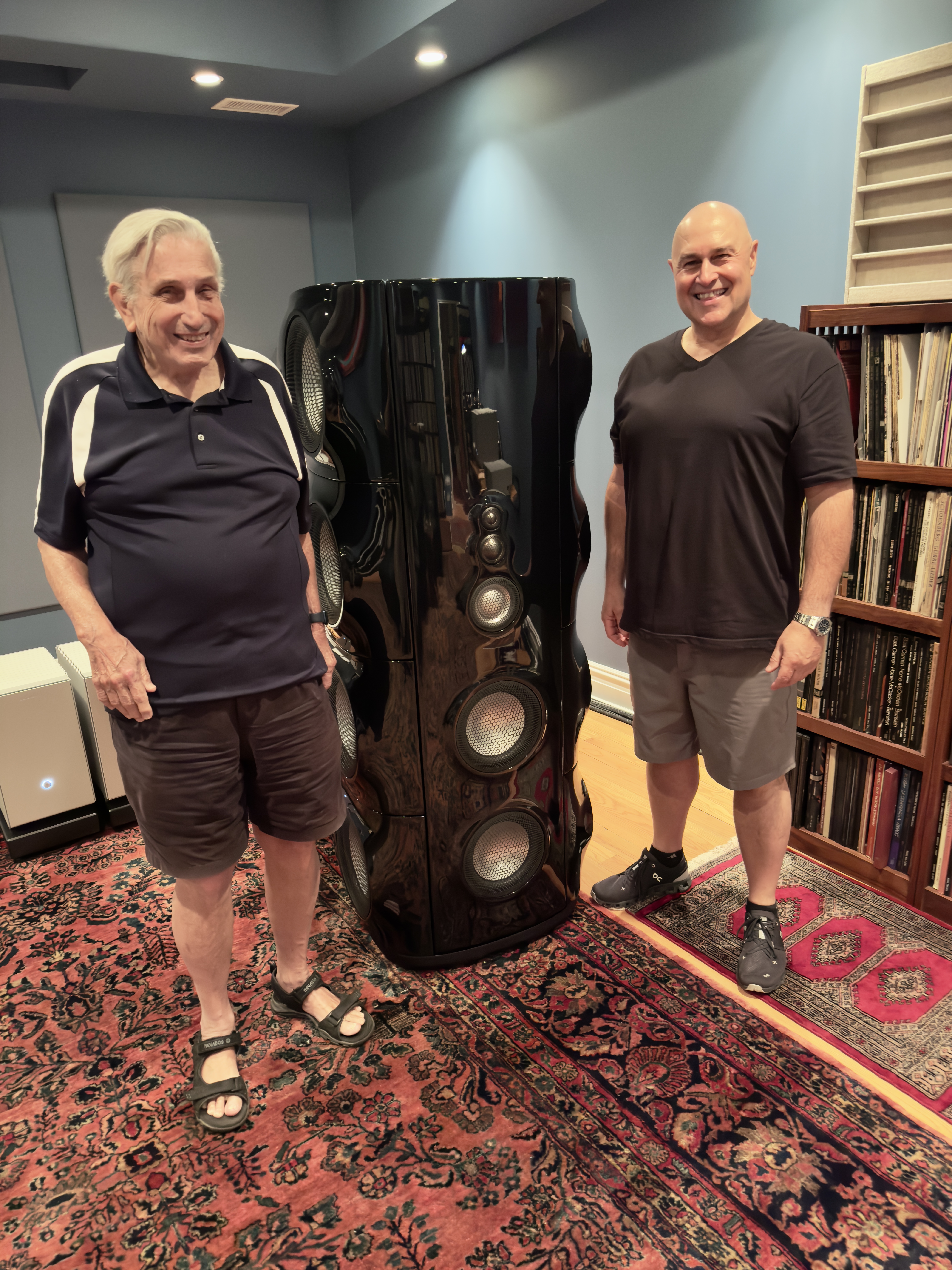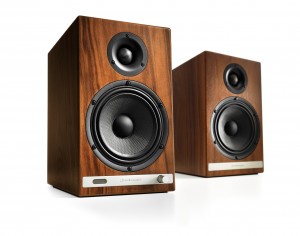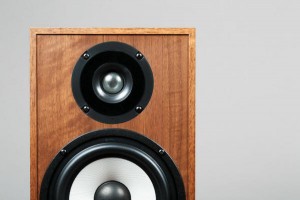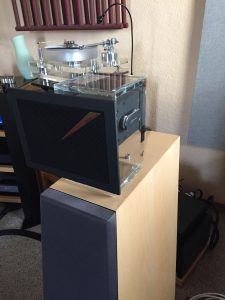World Premiere Review!
A very high quality speaker with unique sound.
With this article, Positive Feedback continues its content-sharing relationship with Enjoy the Music where Rick Becker shares his thoughts on the Treehaus Audiolab Phantom of Luxury Loudspeaker.
Dr. David W. Robinson, Editor-in-Chief
Tom and I had been thirsting for Capital AudioFest 2021 for a month. Being hyper-vigilant and feasting on the science about Covid made it an on-again-off-again decision. If we went for just Friday there would be fewer people and most of them would be old farts like us who not only had the vaccine, but also the booster. Then a distant family member died in upstate Connecticut. The funeral would be Thursday. Linda and I would have to drive through NYC at rush hour to get to Maryland that night. Tom would have to drive down from Rochester alone. It was just a plan, but it was do-able.
I printed out the floor plans earlier in the week and could make very little sense of the third floor. Using the list of vendors and brands represented I labeled each room in the show in tiny print. Next, with a highlighter I identified eighteen "must see" rooms that I would hit early in the day before the show got crowded. Some others I highlighted just a brand name or two that interested me. But who the hell is Treehaus Audiolab?
As a kid I grew up in burgeoning suburbs at the cutting edge of the post-war Baby Boom. I'd 'borrow' scraps of lumber from new homes under construction and build forts and tree houses, honing my carpentry skills and nurturing a 'can-do' attitude. So Treehaus Audiolab caught my attention, though it was low on my list. I found them on my second go-around in the mid-afternoon.
Walking into their room awakened my life-long roots in the furniture industry as well as the Adirondacker in my soul. Two tall slabs of live-edge lumber stood as open-baffle speakers equipped with full-range field-coil drivers from vintage German theater speakers. They had been fully reconditioned and supplemented with a vintage 12" field coil woofer and modern super-tweeter making them realistically full-range. Even more to my liking, they were driven by a tube preamp and tube power amp, also of Treehaus manufacture. Listening to the fine quality of the music, I was stunned to learn this was their very first show—ever! I talked with Rich Pinto, the designer, and made it very clear I wanted to review his speakers and had both tube and solid-state amps to drive them. He, in turn, let me know he really wanted to have them reviewed with amps other than his own.
Linda had driven back to Rochester in our Volvo after we had met up with Tom in the morning. For dinner, Tom and I returned to Frederick, MD, where we discovered May's, an authentic seafood house. The scallops and fries were outstanding, but Linda had forgotten to warn me they grossly overcook kale in the south. I should have bought their t-shirt anyways. Tom and I spent a second night in Frederick before heading up to Allentown, PA, on Saturday. Tom had arranged to audition some speakers at BEK Audio, next door to a record shop that was doing a booming business that afternoon. It was a very worthwhile stop. That evening I piloted Tom's Volvo home to Rochester, arriving in plenty of time for SNL.
The Day Of Arrival
By the end of November Rich pulled his Volvo, loaded with the Phantom of Luxury, into my driveway. (Do you sense a theme, here?) The drivers were packaged in boxes and the heavy wood baffles were wrapped in moving pads. What I had failed to notice at the show was the speakers were bi-amplified and there is a separate tube power supply for the field coil full-range drivers and woofers. Fortunately, I was equipped with enough tube and solid-state amps to accommodate driving the Treehaus with all tube, all solid-state, or a combination of the two.
The complexity arose with trying to maintain a consistent loom of Synergistic Research Foundation interconnects and speaker cables. I was forced to delve into my cable closet for some older cables and power cords from Synergistic, JPS Labs and Audio Sensibility which were used in less critical connections. Obviously, this required more power cords and outlets than usual. During the review period, I had to pull some plugs and switch power cords whenever I wanted to fire up my tuner or listen to an LP. Had this been a permanent installation, I would have rearranged gear, cables and outlets for seamless operation.
The Atelier Rullit drivers were mounted onto the 2" thick slab of elm with custom machined brass clamps with nylon pads to keep from scratching the painted baskets of the drivers and provide some isolation from vibrations.
Custom brass footers are attached to the black maple frame that provided additional support for the baffle as well as an attachment point for the legs that gave the speaker four points of contact with the floor. The secure structure provided welcome stability when I had to slide behind them to open and close the honeycomb window shades. Also, seen above, are the cables that are neatly secured in routed out channels in the baffle. The wiring was very tidy.
The Fostex T900A super tweeter is simply nested in a wood cradle and held in place with a leather strap. The short wavelengths at such high frequencies are not critical to alignment with the other drivers. This driver crosses over to the full-range Rullit driver at about 14-15kHz with a first-order slope. Closer inspection reveals that round wood dowels upon which it rests are made from PlyBoo, plywood layers of bamboo. The layers are aligned perpendicular to the cylinder so vibrations must pass through all layers, aiding in absorption of micro-vibrations. The black maple blocks support the tweeter even further and are indicative of the attention to detail paid to the design of the entire speaker.
The super tweeter and full-range driver, as well as the supplemental Rullit field coil woofer, were positioned on the baffle with aesthetic consideration of the character of the grain, and the baffles themselves are a book-matched pair. All of the drivers were mounted on the back side of the slab. The openings were smoothly radiused to the front surface, creating a shallow horn for each driver. At times, I thought I could notice that slight effect with certain voices or instruments, but it got better later on, as you will read.
The finish on the bare wood is a low sheen satin, almost a mat, but with just enough sheen to let you know it is coated. The wood itself is finely sanded and the coating is a catalyst-cured hand-rubbed oil finish that is very durable and does not show fingerprints. From the furniture perspective, this is first-class workmanship.
Yes, those are solid copper Cardas binding posts. To their right are the Neutrik power connectors for the electric field-coil magnets for the full range driver and woofer. The small toggle switch below the large silver dial selects a range of adjustment for the gain on the super tweeter. The –10/21 dB position was the one that had any significant effect. And the 11-position silver knob is a Fostex attenuator that provided incremental adjustment to the super tweeter via a 1st order crossover with a single Milflex capacitor. Remember the speakers in the 70s with L-pads on the tweeter? It's back to the future all over again. Rich had set the super tweeter low and encouraged me to only make small adjustments. Being considerably younger than me, I suspect he had no idea how hearing diminishes as people age. For now, let's just say I found this knob extremely important.
Details, Details
The Atelier Rullit "Super-Aero" full-range driver runs from 80Hz to about 15kHz without a crossover in its path. The crossover from the woofer to the full-range driver, as well as the frequency response of the woofer itself, is controlled by a MiniDSP which is programable from the listening position once the speakers are positioned.
Another stroke of luck was that my Coincident Statement Line Stage had dual RCA outputs (in addition to an alternate XLR output.) One RCA interconnect ran directly to the power amps (monoblocks) driving the full-range drivers and super-tweeters. The second set of RCA interconnects ran to the MiniDSP (which was powered by a wall wart, requiring another AC outlet.) The output of the MiniDSP (RCA) then ran to the stereo amp driving the woofers.
As with the external power supply for my DAC, I was dismayed by the flimsy DC power wire running to the MiniDSP from the wall wart. It is so feeble I can't really call it a cord. (As a winter DIY project I intend to replace the captive DC power cord on my DAC—stay tuned.) For that matter, the MiniDSP itself is a pretty small and lightweight item, especially considering it houses an A/D and D/A converter. Rich did a quick set-up of the bass response and crossover point which later proved to be unsatisfactory, but it provided a starting point for an important learning experience for me.
The next item that needs explanation is the tube-powered field coil power supply. Instead of a conventional permanent magnet found in typical dynamic drivers, field coil drivers have a large 'can' at the back end that houses a huge winding of wire, not unlike a transformer, that generates a strong magnetic field when electricity is passed through it. But not just any electricity will do if you're aiming for high-end music reproduction; it must be very clean Direct Current. The field coil is designed to provide a consistently high-powered magnet and the drivers are sensitive to the voltage supplied to them. Changing the voltage will soften or harden the sound and alter the efficiency of the driver as well.
Given that the power supply is tube powered, it should be turned on at the start and off again at the end of a listening session to preserve tube life. On one occasion when listening to Hearts of Space on NPR the music was rather annoying which is unusual for this program. Given that the episode was largely electronic music and the quality of the signal sometimes gets disturbed by activity in the ionosphere, I didn't think much of it. Until, that is, I went to shut down the rig and discovered that I had not powered up the field coil power supply. I should have noticed this when I had to adjust the volume higher than usual. With more conventional music you will notice this oversight quickly. You will want to have the power supply where it easily integrates with your start-up and shut-down rituals.
Treehaus has designed the high voltage DC power supplies for the Rullit speakers with two power transformers feeding two pair of 6CJ3 TV Damper rectifier tubes — one going to the full-range driver and the other going to the woofer, each followed by an adjustable voltage regulator. Adjusting the voltage allows for tweaking the sound to your personal preference.
Relatively affordable Belden 9497 speaker cable, a favorite of fans of Shindo gear, connects the power supply to the crossover panel at the base of each speaker. The placement of the power supply need not be close to the speakers themselves. The cable length can be specified to your need. The cables are terminated with Neutrik connectors that are color coded—blue for the full-range drivers, gray for the woofers. For purposes of this review, we placed it for easy access on the floor by the left speaker as the rack and adjacent floor space was full. It should be turned on and off at each listening session to preserve tube life, but it is not something you have to adjust frequently. The unit is constructed like a fine amplifier and at most the voltage varied by a tenth of a Volt.
Power
For clarification, the DC power system running to the field coil drivers is completely separate from the AC signal carrying cables and crossovers. We started out with it plugged into an ordinary wall outlet, but later I was able to route it to the dedicated line used for the entire rig. This seemed to provide a slight improvement. Rich runs the field coil DC power cables to the same plate on the speaker that houses the crossover for reasons of convenience and elegance. With the bottom plate of the power supply removed, you can see how well designed it is. The wood frame is carved out of a thick butcherblock slab of Wenge wood, making for a very substantial chassis. This power supply seen here is from his demo system for audio shows and matches the amplifiers he uses. It can also be ordered in distinctive veneers or solid wood to match the speakers.
To summarize briefly, aside from speaker placement in the room and distancing the listening chair from the speaker, there are three main points of adjustment for the speaker. First to be adjusted is the voltage for the full-range speaker. Rich had set that for me and I didn't really play with it very much, though it can be cranked up to over 110V. It is designed to self-protect from being overdriven. Second, is the attenuation of the super tweeter. And third is the programing of the MiniDSP for crossover point and contouring the bass. Once these parameters have been set you should be good to go without further daily adjustment. Rich points out:
"These speakers can be a bit more complicated at first, but once you get into the DSP for the woofer, the voltage adjustment, and tweeter adjustment, they can really be dialed in to accommodate the listener, the other equipment, the room, and musical taste."
Original SPL Chart
After listening for a week with only moderate enthusiasm for the speaker I pulled out my Radio Shack SPL meter. I simply wasn't getting the quality of music I heard at the show. The 160Hz to 6kHz shown on the chart was actually pretty good for a crude in-room measurement for a system that has not been digitally corrected. But while the bass sounded tight, it was weak in volume and likewise, the treble was prematurely rolled off.
Rich informed me that bumping up the voltage to the full-range driver will raise the treble a bit, but I felt like I needed more than just a slight boost so I turned my attention to the super-tweeter attenuator. I bumped it up two notches at a time until I reached the top. It was a bit bright, so I backed it down a notch. While these frequencies are far above what I can recognize as test tones in a typical hearing test, the sense of air and spaciousness it brought to the music was undeniable. This was not the first time I've had this experience with a super-tweeter.
Rich was likewise dismayed with the setting on the MiniDSP, so he sent a second unit, pre-programed with four different crossover points and boosts to the bass, all selectable with the push of a button on the included Apple remote. The remote also allowed adjustable volume for each of the settings. For my convenience he labeled the inputs and outputs of the MiniDSP on tape, as seen in the photo far above.
A more computer savvy owner can download the MiniDSP app onto a tablet or laptop, and with the help of a microphone program the room corrections into the MiniDSP, as well as tweak the settings as they listen to music from their chair. There are 10 filter positions, each of which can apply a variety of parametric EQ functions and be set at any frequency. Rich had done this when he delivered the speaker, but once I had reviewed some familiar music it became obvious that further tweaking was needed.
With the new MiniDSP installed and Apple remote in hand, it was relatively easy to run through the preset bass profiles Rich had supplied to find the one that worked the best. Trying to learn how to program the MiniDSP would have put this review out another month, given my aptitude for computers, but it is easy to understand that a very smooth bass response is achievable (with the exception of a suck-out caused by room node cancelations.) Here's what the SPL chart looked like after the tweaking with the changes marked in red. Again, this is just a crude Radio Shack meter result.
Second SPL Chart
The 2nd chart shows the maximum setting of the bass in the MiniDSP setting Rich had encoded in the new MiniDSP. It also shows the maximum treble setting I was able to achieve using the super tweeter knob on the crossover. Both of these settings were too strong. I took a step down in the bass with an alternate pre-set, and dialed the super tweeter back several notches. What looked to be closer to a flat frequency response on this chart was actually quite piercing to the ear. Perhaps this is the fault of the Radio Shack analog SPL meter which is known to be less than accurate at both frequency extremes. It is usually best to trust your own ears, which is what I did.
What I Heard
The first thing that hit me with the Treehaus is the transparency of the music. Not just the music, but the musicians are right there in front of you. The high resolution obviously contributes to this presence, but you can have high transparency with lower resolution and vice versa. When you have them both, it is captivating.
The next most prominent feature is the dynamics, particularly the macro variety. A rim shot or the attack of an electric guitar string comes at you right out of the soundstage. Most of the music is anchored with precision on the soundstage behind the plane of the speakers, extending out beyond the front wall for however many feet is appropriate for the recording. Orchestras go way back, rock bands not so far. Soloists and small groups are typically closer yet.
The sense of air—not just the extension of high frequencies and their overtones, but the air in the venue—is real enough to be breathable. Violins can be sweet enough to be fattening, or raw and bitter, depending on the recording. There is no place to hide on such a transparent soundstage. The notes have a fast attack when played that way, and a rapid decay. The huge magnets of the field coil drivers have complete control of the cones, generating not only the notes, but the space between the notes wherein the ambient room tone resides. With the very high 102dB efficiency of the speaker, the music just happens as if there were no time delay between the laser or the stylus and the phantom musicians on the soundstage.
The soundstage was slightly narrower than I typically experience with box speakers with dome tweeters. Only on occasion did the music extend beyond the outer edges of the speaker. It also seemed to be slightly higher that my seating position. Perhaps both phenomena are related to the 7' distance between the full-range drivers and the 9' distance from the drivers to my ears, or the speakers being on the long wall of the room. The drivers themselves were roughly 5.5' from the front wall behind them. I didn't have much leeway in positioning the speakers. In any case, neither factor was an issue after I became accustomed to the speakers and the soundstage was always very stable and well defined. Given the physicality of the instruments and the holographic presence of the performers, to describe the soundstage as pinpoint imaging would be slanderous.
While the overall resolution was focused and tight, I found using my AGD solid-state GaNFET monoblocks (100 Wpc) on the bass and either my Eddie Wong Tube Magic Canada monoblocks (18 Wpc) or my Coincident Turbo 845 SE integrated amp(28 Wpc), both SET designs, on the full-range driver and super-tweeter provided the best continuity of resolution. Using the Coincident (tube) amp on the bass drivers gave a slightly softer resolution than the AGD amps with their fast GaNFET transistors. Neither combination was less than enjoyable, but there were subtle differences.
Likewise, going all solid-state or all tube amplification provided great results with a bit more holographic soundstage coming with the all-tube combination. With the high efficiency of the Phantom of Luxury, the important point is to have quality amplifiers as these speakers are so revealing of the gear that is upstream. You don't need higher powered amplifiers unless your room is very large, like on the order of a ballroom.
Once the bass adjustment was made with the new MiniDSP it blended right in with the full-range driver. Further fine tuning with a computer would likely have made it slightly better. It was always a tight sounding bass, perhaps because the voltage had been pumped up to 115 volts. I always felt I could taste the skins on the drums, a consequence of vivid tonal color. What was missing was the blur caused by overshoot in typical drivers. The field coil bass starts and stops precisely with very little decay unless it is encoded on the recording such as the classic "Tin Pan Alley" by Stevie Ray Vaughn. Consequently, the precision of drummers becomes much more evident and inviting as I heard on Planet Drum and just about every well-recorded rock record I played. Percussion, overall, was always intriguing and not as buried in the mix, even at lower volumes.
In most parameters the Phantom of Luxury surpasses my Kharma Ceramique 2.2, yet the change from a box speaker to this open baffle design brings with it a slight shift in tonal color just as you would expect in going from a box speaker to an electrostatic or from Kodachrome to Ektachrome film. Whether this is due to open baffle design or the performance of the field-coil drivers, I don't know. I'd have to revisit another open baffle design with more conventional dynamic drivers to answer that question.
Regardless, the more I listened to the Phantom of Luxury the more I grew to love it. I stopped casual reading while playing music and paid attention to the music like I had paid admission to hear it. While a lot of tweaks and component improvements have staved off any urge to upgrade from the Kharma, the Phantom has seriously challenged my old way of thinking.
This is not my first review of an open baffle speaker. The first-ever review of a Tekton Design speaker was my review of their small open baffle OB 4.5 monitor in 2009. This little monitor was quite good within the limitations of the 4.5" full range driver. My review of the PureAudioProject Trio 15 TB open baffle design was their first ever full review as well, in 2015. The magic of open baffle speakers has become well known in recent years as other companies have joined their ranks.
The music gets "out of the box" because there is none. Yet the Treehaus, like the others, does not visually disappear because these speakers can have such a visual presence in the room. Even when I listened in the dark with just a reading lamp aimed at my lap, the Treehaus was visible in my peripheral vision. Perhaps if it was ordered in walnut with a dark stain it would visually disappear. The exposed field coil cones blend in nicely with either a dark or light finish and the brass super-tweeter is small and less obtrusive. But do you really want this speaker to disappear?
Style And Customization
After college in the late 1960s one of my buddies lost his father at an early age. His mother was a spark plug. She sold their upper-middle class home in Aurora, Illinois, outside of Chicago and moved to a sleepy ski town in Colorado, buying a contemporary home on a residential mountainside overlooking the main ski slopes. I would drop in to see them on my occasional adventures out west to bicycle high mountain passes. In the vernacular of the day, I was "just passin' through" and I thought it was a pretty cool 'dig'. Long story short, many years later she died and the place sold for $3,000,000. Next time through town I drove my wife up the hillside to show her the place.
It had been torn down and replaced with a three story, single family mega-lodge that for sure had cost many more millions of dollars. The great room overlooking Aspen mountain was two stories high from which they could watch skiers or hang gliders across the valley, depending on the season. This is one setting where the Phantom of Luxury belongs and is meant to be seen.
Another such place might be one of the homes along the drive around Mirror Lake in Lake Placid, that, while smaller in scale, have a similar mountain flavor and appreciation for the wilderness. The lakes and mountains are typically where people establish expensive vacation homes and these can be found throughout the country…and the world. Of course this is not to say the Phantom of Luxury would be out of place if you have an urban loft in Brooklyn.
The live edge movement in commercial furniture has grown out of the twigs & bark rustic furniture that was typically made from hickory. The only successful large scale commercial company in the USA today is the Old Hickory Furniture Company, founded in 1890. Nonetheless, the style has proliferated with very small companies and individual artisans producing truly outstanding one-of-a-kind pieces that command high prices. A large rustic deacon's bench created by a local artisan in my home town is said to have sold for $5k to an NFL football player.
Rustic styling has also bridged into what might be considered more modern furniture. Its popularity in the 2000s led to off-shore manufacturing in the Far East — Malaysia and China. Large dining tables with 2" and 3" thick solid tops require a team of men to deliver them to upper middle class homes and lodges of the wealthy. As a lifelong fan of the Adirondack mountains I've enjoyed the growth of rustic styling and we've decorated our small family room with authentic touches of the ADKs. Alas, these speakers are too large for it.
The Treehaus speakers are obviously not a mass-produced commodity. Each pair is a custom design subject to the desires of the buyer and is dated on the crossover panel. Rich Pinto is a knowledgeable artisan and he can work with you to fit your style and space. Here's an example of a mid-century modern single driver speaker he made for a client. It uses a larger field-coil driver that allows it to be used without a supplementary woofer. Note that there is a hundred-pound soapstone base. This gives a view of a larger Phantom of Luxury three-driver model in a darker stain. The review pair is a bit narrower to be used in hotel rooms at shows, measuring 21" to 22" at the top and 25" to 26" near the bottom, proportions I found quite pleasing.
On the power supply and also on their tube preamp and power amp Treehaus features a custom finish on the metalwork. Rich takes the raw aluminum pieces after machining and soaks them in a chemical bath to achieve a corroded aluminum finish that has a soft touch to it. Rich sees this Treehaus aesthetic as bridging the gap between the vintage tube technology and drivers, and the new technology such as the LED read-outs and DSP. Their logo, which brings to mind point to point wiring, has the shape of a tree and also works to solidify their image. Treehaus can easily go country lodge, urban loft or contemporary, and while it slips easily into a casual setting, it can also become an authentic natural counterpoint to very luxurious décor. If you or your decorator have doubts, check out the entire Phillips Collection website or particularly their page for live edge dining tables here.
Treehaus Audiolab, The Company
Treehaus falls into the artisan category with only Rich Pinto and RaduTarta as the core. Radu is an electronics guru in the realm of tube amplification and power supplies who got his start in 2013. He builds their preamplifier and power amplifier ($16,000 each) based on the designs of Susumu Sakuma of Japan. Rich does the work with speaker and chassis design. He has positioned Treehaus Audiolab somewhat similar to Oswalds Mill Audio, but considerably more affordable. Based in Southport, Connecticut, he envisions his customer as a Brooklyn hipster, someone for whom style is equally as important as function, and not necessarily an audiophile. I can see these speakers in Portland, Oregon, New Orleans, Nashville and wealthy resort communities virtually anywhere. Put a driftwood gray finish on it if you're on the coast.
Treehaus also offers their National Treasure model speaker which is slightly smaller in size, "only" about 24" wide and 52" tall, also in live edge Walnut or Elm. It uses an Atelier Rullit "Aero" full-range field coil driver with tube rectified power supply and a Fostex T90A super tweeter, but scales back the woofer to a conventional dynamic driver with a permanent magnet. This reins in the cost to $16,000 with a smaller power supply as well as the more affordable woofer.
Rich pointed out that their price list contributes consistency to the two models, but he added that he is also open to modifications and filling specific style needs. We see this in the mid-century modern single driver model influenced by Isamu Noguchi above where he goes completely off course from the Phantom of Luxury with just a single 12" full-range driver and layered Wenge wood.
The Atelier Rullitdrivers used here originated from German public address and theater speakers. The full-range driver is the Super-Aero model. The Rullit woofers used in this particular pair of speakers are rare and bump the cost up another $2k. Normally, the Phantom of Luxury comes with a Supravox field coil woofer.
The Atelier Rullit home page is on Facebook.
A knowledgeable friend in Europe shared some background on Oleg Rullit which I believe leans closer to truth than to myth. I've tidied up his writing just a bit but remained true to his intent. He wrote:
"Rullit used to mod old German public address and theater drivers like green-cones, etc., by converting them to field coil speakers, installing alternate spiders or leather surrounds and the like. They are remanufactured speakers from the Klangfilm era (usually Telefunken based). He rewinds the coils, re-cones them with his proprietary paper cones, and uses a new leather surround for the cones. Basically he strips them down to the bare metal structure and then rebuilds them from there, the same way you would restore a car from the 'frame-up'."
Then he started more and more to include his own production elements like his own membranes glued from sheet paper etc.—in the end it is overall acoustic design, materials, and manufacturing tolerances that can make or break a product. Many of those vintage drivers were made for public address systems or theaters. Some were manufactured to shockingly high standards and tight tolerances, and those stand out. Coming from the legendary drivers of yore does not automatically transfer their credibility to his current designs, but without comparing them to the originals, one can't rate his current creations as inferior either.
Certainly, I have not heard the original vintage speakers, so my comments are only in relation to the speakers I've heard over the past three decades. I can also say that celebrated designers tend to improve and surpass their earlier work as they gain experience.
There is a whole cult of people who treasure such vintage gear. My friend continues:
"Sibatone is famous for the demonstration of vintage gear at the High End show in Germany, most of it focused on Western Electric. [YouTube vids here] There are a few [brands] which are stellar performers which really mesmerize: Klangfilm, Zeiss and some other firms [Siemens, Telefunken] did their homework on the higher spec drivers. But we speak of less than 20% of their whole lines, and only if the units are in good condition. Those real gems the Koreans and Japanese identified in the '70s and '80s and bought what they could get their hands on (together will all those 300B tubes and first pressings of vinyl records.) Prices are stellar today for such - but well justified. Some of the legendary gear even made it into a big ticket fashion show in Paris recently.
The Dior Herren Winter 2021-2022 Show with the huge Klangfilm Euronor speakers.
Many of these afficionados live in Europe and the Far East—Japan, Korea, China, Singapore, Malaysia. They worship a level of craftsmanship and sound quality of an era where natural materials and precise handiwork prevailed. Many, if not most of the very best of these drivers exist only in private collections today. Unless you know one of the cognoscenti, chances are you will never get to hear them. While some drivers show up on eBay or cult websites from time to time, it is typically a case of "buyer beware." Make sure you're dealing with a trusted source. This shouldn't scare you away from Treehaus speakers. The Atelier Rullit speakers are likely of that same coveted level of quality and we should be grateful Oleg Rullit has continued this art in this modern age.
Value, Style And Personal Identity
Treehaus Audiolab is not about the price. By the time you add in another set of interconnects, another amplifier, another power cord for that amplifier, and another set of speaker cables required for bi-amplification and the MiniDSP, you are way beyond the price of the speaker alone. And this assumes you have dual RCA outputs on your preamp and a couple of extra AC outlets on your power conditioner. I would also advise you to look for high-quality cables and amplification.
As an article in a furniture trade journal recently pointed out: "The treasure hunting experience of shopping has rebounded after years of transaction-driven time in store. Merchandise curation and storytelling through product vignettes are roles of the showroom that reaffirm the social aspect of shopping." Of course brick and mortar high end shops have been curating their presentations all along, but in spite (or because of) Covid 19 there are a lot of customers out there looking for authentic, quality goods to purchase at higher price points. The "showroom" for Treehaus speakers for the near term will likely be audio shows once Covid has loosened its grip.
There is also the eCommerce Acceleration factor: "The NRF reported, 'in 2020 alone, consumers around the world spent $900 billion more online than in previous years.' Forbes reports on the stickiness of this trend finding that, 74% of global retail and consumer brand professionals said they expect the crisis-led rise in online shopping to become permanent.'" So audiophiles and others may well be looking at reviews and an occasional audio show for insight into Treehaus, while working directly with Rich Pinto to order.
Summary
People will either be drawn to Treehaus Audiolab products because of the style and the story behind them, or they will not. If what I heard at Capital Audiofest in 2021 recurs at other shows in the future, the sound quality will likely close deals. It is a very high-quality speaker with unique sound. They do not sound like Wilson or Magico or YG or other top speakers worshiped or coveted by audiophiles. And they don't look like them either. Many future owners may not even be audiophiles at all, depending on how Treehaus is marketed.
The rustic style and exposed drivers will attest to the personal identify and values of their owner and give them a story to tell their guests. This is not a speaker for an audiophile cloistered in a dedicated listening room, forever unseen by others, but rather for a music lover who entertains and is proud of their décor and has a penchant for finer things in life. Listen to music in solitude if you wish during the week. But also know that you can rock the party in a large room with the Phantom of Luxury with its high sensitivity.
There is an organic wholeness that comes with the 2" thick Elm or Walnut slabs that you don't get with a box speaker or other open baffle designs. The music is very preset. It's very Zen, yet incense, prayer flags or a Buddha are optional. That quality can be your own secret.
The Phantom of Luxury is an extraordinary loudspeaker, tailored to a select few extraordinary music lovers who are comfortable with bi-amplification. It pays homage to the past and brings the vision of a sustainable future into the present. If the wilderness beckons you or the Phantom of Luxury speaks to the urban hipster within, seek them out. Your musical journey on spaceship Earth will be uniquely rewarded. By the end of the decade, Treehaus Audiolab could be well on its way to becoming a global brand.
Hello, Tokyo?
Specifications
- Type: Type: Open-baffle loudspeaker
- Sensitivity: 102dB/W/m
- Impedance / Coil Resistance: 8 Ohm
- Weight: 135 lbs assembled (this does vary a bit depending on the speaker due to the live edge wood used)
- Dimensions: 54" x ~23” x 22” (HxWxD)
- Price: $26,000 as built with upgraded woofers
Treehaus Audio
Southport, CT
Check out Enjoy the Music for more articles and reviews




